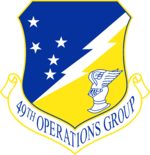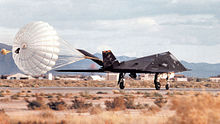| 49th Operations Group | |
|---|---|
 Lockheed Martin F-22A Block 30 Raptor 05-4084 of the 7th Fighter Squadron Lockheed Martin F-22A Block 30 Raptor 05-4084 of the 7th Fighter Squadron | |
| Active | 1941–1957; 1991–present |
| Country | |
| Branch | |
| Type | Group |
| Role | Combat Operations |
| Motto(s) | Tutor et Ultor – "I Protect and Avenge" |
| Engagements | World War II (Asia-Pacific Theater) Korean War Kosovo Campaign Global War on Terrorism |
| Decorations | Distinguished Unit Citation (5x) Air Force Meritorious Unit Award Air Force Outstanding Unit Award (3x) Philippine Presidential Unit Citation Republic of Korea Presidential Unit Citation (2x) |
| Insignia | |
| 49th Operations Group emblem |  |
The 49th Operations Group (49 OG) is the operational flying component of the United States Air Force 49th Wing. It is stationed at Holloman Air Force Base, New Mexico, and is a part of Air Combat Command (ACC).
During World War II, the unit's predecessor unit, the 49th Fighter Group, operated primarily in the Southwest Pacific Theater as part of the Fifth Air Force. The group earned three Distinguished Unit Citations (DUC) for engaging the enemy in frequent and intense aerial combat in numerous campaigns between 1942 and 1945. During the Korean War, the unit initially covered the evacuation of civilian personnel from Kimpo and Suwon in 1950, later flying missions in support of UN ground forces, hitting gun positions, troop concentrations, and other objectives until the 1953 Armistice, remaining in South Korea for a time afterward.
After the fall of the Soviet Union, 49th Operations group F-117A Stealth fighters were engaged in combat during Operation Allied Force in 1999, and in Operation Iraqi Freedom in 2003.
Overview
The 49th Operations Group (Tail Code: "HO") conducts training using the MQ-9 Reaper.
Units of the 49th Operations Group are:
- 49th Operations Support Squadron
- The 49th Operations Support Squadron is made up of seven flights including Weather, Aircrew Flight Equipment, Airfield Operations, White Sands Radar, Intelligence, Current Operations and Weapons and Tactics. These flights support the wing, tenant units and Army's White Sands Missile Range. The Weather Flight provides operational observing, forecasting and staff weather support. They provide 26 specific types of weather warnings and advisories to 60 base agencies to ensure resource protection and flight safety of base assets worth over $7 billion.
- 6th Attack Squadron (MQ-9)
- A USAF FTU (Formal Training Unit) where pilots and sensor operators undergo Initial Qualification Training to operate the MQ-9 Reaper. On 23 October 2009, the 6th was reactivated as the 6th Reconnaissance Squadron at Holloman AFB, and assumed its mission of providing Initial Qualification Training for pilots and sensor operators learning to operate the MQ-1 Predator remotely piloted aircraft. It eventually retired the MQ-1 and began training students on the MQ-9.
- 9th Attack Squadron (MQ-9)
- On 4 October 2012, the 9th Fighter Squadron was redesignated and activated as the 9th Attack Squadron which will train new pilots and sensor operators for the MQ-9 Reaper.
- Provides academic and simulator instruction to pilots and sensor operators learning to fly the MQ-9 Reaper remotely piloted aircraft, using the Predator Mission Aircrew Training System.
- 29th Attack Squadron (MQ-9)
- A USAF FTU where pilots and sensor operators undergo Initial Qualification Training to operate the MQ-9 Reaper.
- 491st Attack Squadron (MQ-9)
- 492d Attack Squadron (MQ-9)
- A USAF FTU where pilots and sensor operators undergo Initial Qualification Training to operate the MQ-9 Reaper.
History
- For additional lineage and history, see 49th Fighter Wing
World War II
The 49th Operations Group traces its origins to the formation of the 49th Pursuit Group (Interceptor) at Selfridge Field, Michigan on 20 November 1940. The group trained with Seversky P-35s and consisted of three operational squadrons (7th, 8th, and 9th).

With the advent of World War II, the group moved to Australia and became part of Fifth Air Force in January 1942. It was re-designated as the 49th Fighter Group in May 1942. The unit received Curtiss P-40 Warhawks in Australia and, after training for a short time, provided air defense for the Northern Territory, being awarded a Distinguished Unit Citation for engaging the enemy in frequent and intense aerial combat while operating with limited materiel and facilities for the period March–August 1942.
The group moved to New Guinea in October 1942 to help stall the Japanese drive southward from Buna to Port Moresby. Engaged primarily in air defense of Port Moresby; also escorted bombers and transports, and attacked enemy installations, supply lines, and troop concentrations in support of Allied ground forces.
The 49th participated in the Allied offensive that pushed the Japanese back along the Kokoda Track, took part in the Battle of the Bismarck Sea in March 1943, fought for control of the approaches to Huon Gulf, and supported ground forces during the campaign in which the Allies eventually recovered New Guinea. It covered the landings on Noemfoor and had a part in. the conquest of Biak.
After having used Lockheed P-38 Lightnings, Curtiss P-40 Warhawks and Republic P-47 Thunderbolts, the 49th was equipped completely in September 1944 with P-38's, which were used to fly long-range escort and attack missions to Mindanao, Halmahera, Seram, and Borneo. The unit arrived in the Philippines in October 1944, shortly after the assault landings on Leyte and engaged enemy fighters, attacked shipping in Ormoc Bay, supported ground forces, and covered the Allied invasion of Luzon. For or intensive operations against the Japanese on Leyte, the group was awarded a Distinguished Unit Citation.
Other missions from the Philippines included strikes against industry and transportation on Formosa and against shipping along the China coast. By the war's end, the group's pilots destroyed 668 enemy aircraft (there may be some disagreement here as the 49th group site lists 678 but most sources agree at 668), a record surpassing that of any other fighter group in the Pacific Theater. The group's World War II activities merited two Philippines Republic Presidential Unit Citations, three U.S. Distinguished Unit Citations, and 10 battle honors. Among the unit's 43 aces were Lt. Colonel Boyd D. "Buzz" Wagner, the first World War II ace in the Pacific Theater, and Major Richard I. Bong, whose 40 kills made him America's number one ace (a record that still stands). The 49th soon became endeared to the American people through the nickname, "Fighting 49ers."
Cold War

The 49th moved to Okinawa in August 1945 and to Japan in September. As part of the Army of occupation in Japan, the 49th Fighter Group trained, took part in maneuvers, and flew surveillance patrols, as part of Far East Air Forces. The group was equipped with North American P-51 Mustangs in 1946, with Lockheed F-80 Shooting Stars being added in 1948.
On 10 August 1948, with the adoption of the Hobson Plan, the United States Air Force 49th Fighter Wing was activated, with the 49th Fighter Group being assigned as its combat group. From this point, the history of the 49th Fighter Group is indistinguishable from that of the 49th Fighter Wing. Significant changes to the organization were:
- On 1 February 1950, the group was re-designated as the 49th Fighter-Bomber Group
- On 10 December 1957, the 49th Fighter-Bomber Group was inactivated when the wing adopted the Dual Deputy Organization and assigned all combat squadrons directly to the wing; the combat group commander becoming the wing Deputy Commander for Operations (DCO). The honors and history of the Group were temporarily bestowed to the 49th Fighter-Bomber Wing upon inactivation of the Group.
- On 31 July 1985, while inactive, the group was re-designated as the 49th Tactical Fighter Group
After the fall of the Soviet Union
On 1 November 1991, the 49th Tactical Fighter Wing adopted the Air Force Objective Organization plan and the 49th Tactical Fighter Group was re-designated as the 49th Operations Group and re-activated. The operational squadrons of the wing came under the control of the Operations Group. The 49th Operations Group was transferred the lineage, honors and history of the 49th Fighter Group.
The 7th Fighter Squadron, flying F-22s, was inactivated on 2 May 2014.
Lineage

- Established as 49th Pursuit Group (Interceptor) on 20 November 1940
- Activated on 15 January 1941
- Re-designated: 49th Fighter Group on 15 May 1942
- Re-designated: 49th Fighter Group, Single Engine, on 20 August 1943
- Re-designated: 49th Fighter Group on 6 November 1944
- Re-designated: 49th Fighter-Bomber Group on 1 February 1950
- Inactivated on 10 December 1957
- Re-designated: 49th Tactical Fighter Group on 31 July 1985 (Remained Inactive)
- Re-designated: 49th Operations Group on 1 November 1991
- Activated on 15 November 1991.
Assignments
|
|
Components
- 6th Attack Squadron
- 7th Pursuit (later, Fighter; Fighter-Bomber; Fighter; Combat Training; Fighter) Squadron: 16 January 1941 – 10 December 1957; 15 November 1991 – 2 May 2014
- 8th Pursuit (later, Fighter; Fighter-Bomber; Fighter) Squadron: 16 January 1941 – 10 December 1957; 15 November 1991 – 2007; 25 September 2009 – 19 May 2011
- 9th Pursuit (later, Fighter; Fighter-Bomber; Fighter) Squadron: 16 January 1941 – 10 December 1957; 15 November 1991 – present
- 20th Fighter Squadron: 1 July 1993 – 20 December 2004
- 29th Attack Squadron: 23 October 2009 – present
- 48th Rescue Squadron: 1 May 1993 – 1 February 1999
- 415th Fighter Squadron: 8 July 1992 – 1 July 1993
- 416th Fighter Squadron: 8 July 1992 – 1 July 1993
- 417th Fighter Squadron: 8 July 1992 – 1 December 1993
- 433d Fighter Squadron: 15 November 1991 – 8 July 1992
- 435th Fighter Squadron: 12 May 1993 – 1 April 1997
- 491st Attack Squadron: 15 April 2019 – present
- 492d Attack Squadron: 15 April 2019 – present
Stations
|
Aircraft
|
|
See also
References
![]() This article incorporates public domain material from the Air Force Historical Research Agency
This article incorporates public domain material from the Air Force Historical Research Agency
- ^ "Units". Holloman Air Force Base. Retrieved 5 October 2016.
- Burrett, James (16 October 2012). "History of the 9th Attack Squadron". 49th Wing History Office. Retrieved 5 October 2016.
- Kane, Robert B. (1 March 2016). "16 Training Squadron (ACC)". Air Force Historical Research Agency. Archived from the original on 4 March 2016. Retrieved 5 October 2016.
- ^ "49th Wing History". 49th Wing Public Affairs Office. Retrieved 5 October 2016.
- Protect & Avenge S. W. Ferguson and William K. Pascalis
- Hess 2004, p. 123.
- ^ Kane, Robert B. (22 September 2010). "Factsheet 49 Operations Group (ACC)". Air Force Historical Research Agency. Retrieved 11 May 2016.
- Bibliography
- Ferguson, Steve W. and William K. Pascalis. Protect & Avenge: The 49th Fighter Group in World War II. Atglen, Pennsylvania: Schiffer Publishing, 1995. ISBN 0-88740-750-1.
- Hess, William N. 49th Fighter Group: Aces of the Pacific. Botley, Oxford, UK: Osprey Publishing Ltd., 2004. ISBN 1-84176-785-9.
- McAuliffe, Lt Col Jerome J. (2005). "Chapter 5, Etain-Rouvres Air Base". U.S. Air Force in France 1950–1967. San Diego, CA: Milspec Press. ISBN 978-0-9770371-1-7.
- McDowell, Ernest R. 49th Fighter Group. Carrollton, Texas: Squadron/Signal, Inc., 1989. ISBN 0-89747-221-7.
- Maurer, Maurer, ed. (1983) . Air Force Combat Units of World War II (PDF) (reprint ed.). Washington, DC: Office of Air Force History. ISBN 0-912799-02-1. LCCN 61060979.
- Thompson, Warren. F-84 Thunderjet Units Over Korea. Botley, Oxford, UK: Osprey Publishing. 2000. ISBN 1-84176-022-6.
- Thompson, Warren. F-80 Shooting Star Units over Korea. Botley, Oxford, UK: Osprey Publishing, 2001. ISBN 1-84176-225-3.
| Bases (current) |    | ||||||||||||||
|---|---|---|---|---|---|---|---|---|---|---|---|---|---|---|---|
| Units (current) |
| ||||||||||||||
| Units (wartime) |
| ||||||||||||||
| USAF units and aircraft of the Korean War | |||||||||||||||
| Previously: Philippine Department Air Force (1941); Far East Air Force (1941-1942) | |||||||||||||||||||||||||||||
| Airfields |
|  | |||||||||||||||||||||||||||
| Units |
| ||||||||||||||||||||||||||||
| |||||||||||||||||||||||||||||
